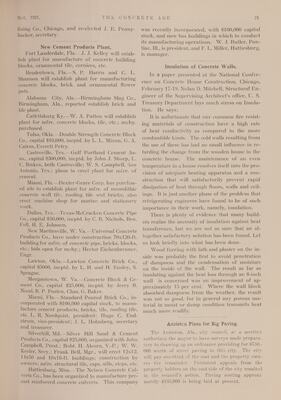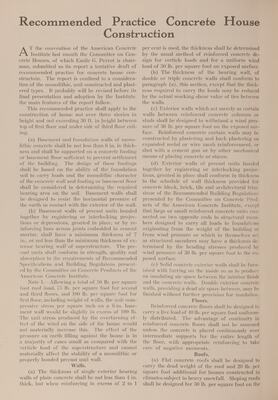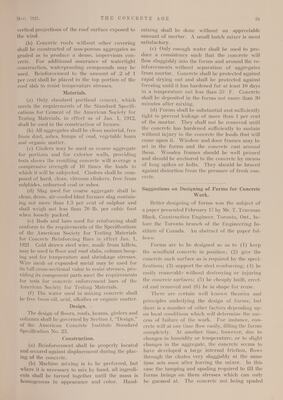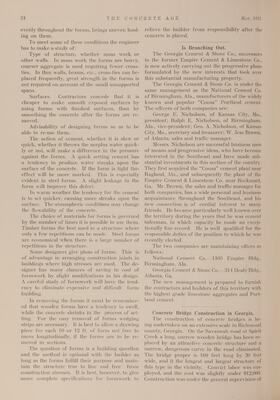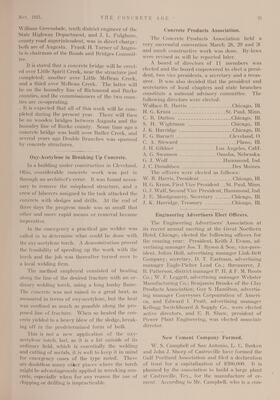Pages
21
This page is not corrected, please help correct this page
22
Recommended Practice Concrete House Construction AT the convention of the American Concrete Institute last month the Committee on Concrete Houses, of which Emile G. Perrot is chairman, submitted as its report a tentative draft of recommended practice for concrete house constructoin. The report is confined to a consideration of the monolithic, unit constructed and plastered types. It probably will be revised before its final presentation and adoption by the Institute, the main features of the report follow. This recommended practice shall apply to the construction of house not over three stories in height and not exceeding 30 ft. in height between top of first floor and under side of third floor ceiling. (a) Basement and foundation walls of monolithic concrete shall be not less than 6 in. in thickness and shall he supported on a concrete footing or basement floor sufficient to prevent settlement of the building The design of these footings shall be based on the ability of the foundation soil to carry loads and the monolithic character of the concrete wall and footing or basement floor shall he considered in determining the required hearing area on the soil. Basement walls shall he designed to resist the horizontal pressure of the earth in contact with the exterior of the wall. (b) Basement walls of precast units bonded together hv registering or interlocking projections or depressions, grouted in place, or by reinforcing bars across joints embedded in cement mortar, shall have a minimum thickness of 7 in., or not less than the minimum thickness of exterior bearing wall of superstructure. The precast units shall conform in strength, quality and absorption to the requirements of Recommended Specifications and Building Regulaions presented by the Committee on Concrete Products of the American Concrete Institute. Note I.—Allowing a total of 50 lb. per square foot roof load, 75 lb. per square foot for second and third floors, and 100 lb. per square foot for first floor, including weight of walls, the unit compressive stress per square inch on a 6-in. basement wall would he slightly in excess of 100 lb. The unit stress produced by the overturning effect of the wind on the side of the house would not materially increase this. The effect of the pressure on earth filling against the house is in a majority of cases small as compared with the verticle load of the superstructure and cannot materially affect the stability of a monolithic or properly bonded precast unit wall. Walls. (a) The thickness of single exterior bearing walls of plain concrete shall be not less than 4 in. thick, but when reinforcing in excess of 2 to 1 per cent is used, the thickness shall be determined by the usual method of reinforced concrete design for verticle loads and for a uniform wind load of 30 lb. per square foot on exposed surface. (b) The thickness of the bearing wall, of double or triple concrete walls shall conform to paragraph (a), this section, except that the thickness required to carry the loads may be reduced by the actual working shear value of ties between the walls. (c) Exterior walls which act merely as curtain walls between reinforced concrete columns or studs shall be designed to withstand a wind pressure of 30 lb. per square foot on the exposed surface. Reinforced concrete curtain walls may be constructed by plastering and back plastering on expanded metal or wire mesh reinforcement, or shot with a cement gun or by other mechanical means of placing concrete or stucco. (d) Exterior walls of precast units bonded together by registering or interlocking projections, grouted in place shall conform in thickness to the schedule of wall thickness provided for concrete block, brick, tile and architectural trimstone of the Recommended Building Regulations presented by the Committee on Concrete Products of the American Concrete Institute, except that large or small reinforced concrete units connected on two opposite ends to structural members designed to carry all loads to foundations originating from the weight of the building or from wind pressure or which in themselves act as structural members may have a thickness determined by the bending stresses produced by wind pressure of 30 lb. per square foot to the exposed surface. (e) Solid concrete exterior walls shall be furnished with furring on the inside so as to produce an insulating air space between the interior finish and the concrete walls. Double exterior concrete walls, providing a dead air space between, may he finished without further provision for insulation. Floors. Reinforced concrete floors shall he designed to carry a live load of 40 lb. per square foot uniformly distributed. The advantage of continuity in reinforced concrete floors shall not be assumed unless the concrete is placed continuously over intermediate supports for the entire length of the floor, with appropriate reinforcing to take care of negative moments. Roofs. (a) Flat concrete roofs shall be designed to carry the dead weight of the roof and 20 lb. per square foot additional for houses constructed in climates subject to heavy snowfall. Sloping roofs shall be designed for 30 lb. per square foot on the
23
This page is not corrected, please help correct this page
24
This page is not corrected, please help correct this page
25
This page is not corrected, please help correct this page
